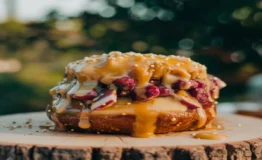Many bakers use cold butter when making chocolate chip cookies. They believe it makes the cookies chewy with crisp edges. A recipe from ‘Stuffed: The Sandwich Cookie Book’ shows how cold, cubed butter from the fridge helps. It makes baking quick and gives you gooey cookies in less than 20 minutes.
Using different types of chocolate chips adds flavor and texture. Measuring ingredients carefully with a kitchen scale is key to a perfect mix of sweet and salty.
Key Takeaways
- Using cold butter can enhance cookie texture.
- Precise ingredient measurements are crucial for perfect results.
- The method emphasizes quick prep and baking time.
- Cold butter helps achieve chewy cookies with crisp edges.
- A variety of chocolate chips contributes to a delightful flavor and texture.
Introduction to Using Cold Butter in Chocolate Chip Cookies
Making the perfect cookie is all about understanding baking science and the importance of each ingredient. Butter is a key player, affecting the taste, softness, and texture. Traditionally, using room temperature butter is advised because it mixes air well. But, cold butter baking is gaining popularity for making chewy chocolate chip cookies.
The Role of Butter in Baking
Butter is essential in baking, influencing the cookies’ moisture, fat content, and rise. Knowing how butter in cookies works helps in achieving the right texture. The butter’s temperature changes how the dough spreads and rises in the oven. Melted butter makes cookies denser and chewier, while room temperature butter results in a lighter dough.
Types of Butter and Their Impact on Cookies
The type of butter you use can change your cookie’s taste and texture. European butter with more fat makes cookies richer and more flavorful. Regular unsalted butter is best for most recipes. Using cold butter baking in chewy chocolate chip cookies gives them a unique texture. Whether you’re trying new cookie ingredients or sticking to classic recipes, the butter’s type and temperature matter a lot.
How Cold Butter Affects Cookie Texture
Using cold butter in cookie recipes changes the final texture of the cookies. Cold butter makes steam pockets during baking, leading to flaky layers. This method is crucial for a chewy center and crisp edges, which many bakers want.
Create the Perfect Chewy Center
Cold butter in cookie dough makes the center tender and chewy. It doesn’t melt fast, letting the dough set before baking. This helps control gluten and keeps the cookies thick, ensuring a chewy texture.
For an even chewier middle, some bakers bake the cookies a bit less. This makes them moister and more tender.
Achieve Crisp Edges
Cold butter is key for crisp cookie edges. As the cookies bake, the butter melts slowly. This lets the dough form a firm, crisp rim before the inside sets.
Techniques like dropping the cookie sheet during baking help control the edges’ crispness. This creates a perfect mix of textures: crunchy outside and soft, chewy inside. Cookie lovers enjoy this combination a lot.
Why Many Recipes Call for Cold Butter
Cold butter is key in many cookie recipes because it makes baking quick and easy. It offers big benefits for both home bakers and professional chefs.
Convenience and Time-Saving Benefits
Using cold butter saves time because you don’t need to wait for it to soften. This means you can start baking right away. It makes the whole process faster and easier.
This convenience is a big plus for those who are short on time. It makes baking more accessible and efficient.
Enhanced Flavor Characteristics
Cold butter also brings out a richer flavor in cookies. It gives them a deeper, more buttery taste. This makes the cookies taste better overall.
It also helps balance the sweetness and saltiness. This unique taste is what makes cookies so special. Plus, cold butter keeps the cookies moist and chewy.
Comparing Cold Butter with Room-Temperature and Melted Butter
Knowing how butter temperature changes cookie recipes is key to baking success. Each butter state—cold, room temperature, and melted—changes the dough’s texture. This leads to different types of cookies. Let’s look at the science behind each state and how they affect cookies.
The Science Behind Each Butter State
Cold butter makes cookies spread less during baking because it’s firm. This creates cookies with a thick texture and clear edges. At room temperature, butter lets more air into the dough, making cookies light and fluffy.
Melted butter makes dough soft and spreads quickly. This results in thin, crispy cookies.
Examples of Cookie Recipes for Each Butter State
Cookies made with cold butter have a chewy center and crispy edges. Classic chocolate chip cookies are a great example. They use cold butter for the perfect texture.
Recipes with room-temperature butter, like sugar cookies, give a tender crumb and even baking. Melted butter is best for making thin, crispy lace cookies.
Steps to Incorporate Cold Butter into Cookie Dough
Using cold butter in your chocolate chip cookie dough changes the texture and taste. Here are key steps for the creaming method and cubing butter. These tips help you get the best results with cold butter every time.
Creaming Cold Butter and Sugar
The creaming method is vital for the right dough consistency. Start by putting cold, cubed butter in your mixing bowl. Begin mixing on low speed, then increase it to medium. Make sure to scrape the bowl sides often to mix butter and sugar well.
Keep mixing until the mix looks light and fluffy, with no butter chunks left.
Tips for Properly Cubing Cold Butter
Getting the butter cubes right is key for even dough. Cut the cold butter into small, uniform pieces. It’s important to have cubes of the same size for even mixing.
Add these cubes to your dough slowly, making sure each piece blends in before adding more. This ensures the butter is spread evenly, making the dough perfectly textured.
Common Mistakes when Using Cold Butter in Cookies
Using cold butter in cookie recipes can make your cookies better if done right. But, there are some mistakes to watch out for to keep your cookies tasting great.
Avoiding Overmixing
One big mistake is mixing the dough too much. When using cold butter, some bakers mix too hard to get the butter in. But this can make the cookies tough instead of soft. It’s important to mix just until everything is mixed well.
Ensuring Even Distribution of Butter
Another big issue is getting the butter spread evenly in the dough. Cold butter can be tricky if it’s not cut into small pieces. This can lead to cookies that are not the same texture. Cutting the butter into small pieces helps it mix well and avoids lumps that can mess up the cookies.
Should Butter Be Cold for Chocolate Chip Cookies?
The cookie baking debate over cold butter for chocolate chip cookies is interesting. Some say cold butter gives a special texture, making perfect cookies. It helps control the dough’s consistency for a chewy center and crisp edges.
On the other hand, some like using room-temperature or melted butter for ease and tradition. These different chocolate chip cookie techniques show how butter’s state affects the cookies. Cold butter might need more mixing but can lead to a unique texture blend.
Personal choices and experiences shape this debate. Some bakers prefer the accuracy of baking with cold butter. Others enjoy the traditional ways. The best choice depends on what cookie experience you want, mixing old and new methods for perfect cookies.
Expert Tips and Tricks for Perfect Chocolate Chip Cookies
Want to take your chocolate chip cookies from good to amazing? Follow some expert baking tips. These tips will help you get consistent results, a perfect texture, and a gourmet look every time.
Using a Kitchen Scale to Measure Ingredients
Getting your cookie ingredients right is key. A simple tip is to use a kitchen scale. It helps you avoid mistakes like too much flour or not enough baking soda. This ensures your cookies turn out consistent and tasty.
The Importance of Not Overbaking
Don’t forget, not overbaking is crucial. Cookies keep baking on the hot sheet even after they’re out of the oven. Take them out a bit early to get that chewy center. This trick is a game-changer, making your cookies soft and delicious.
Creating Gourmet-Looking Cookies
For a pro look, pay attention to how they look. Place a few extra chocolate chips on top of each dough ball before baking. This makes them stand out and look great. Also, shape the dough balls carefully to ensure they bake evenly. This makes your cookies look as good as they taste.
Storing and Freezing Cookies Made with Cold Butter
Keeping your chocolate chip cookies tasty and fresh is an art. Whether you need them for a short time or want to freeze them, knowing how to store them right is key.
For eating now or keeping for a bit, store cold butter cookies at room temperature in a sealed container. Put a piece of bread in the container to keep the cookies soft. The bread absorbs extra moisture, making the cookies stay tender.
If you’re planning to store cookies for a long time, freezing is the way to go. Put the baked and cooled cookies on a baking sheet and freeze them for a few hours until they’re hard. Then, move them to a zip-top freezer bag, squeezing out any air to avoid freezer burn. This keeps your cookies fresh for up to three months.
When you want to eat your frozen cookies, let them thaw at room temperature for an hour. For a warm cookie taste, bake them in a 300°F oven for a few minutes. These steps help you enjoy your cold butter cookies without losing their flavor or texture.
Conclusion
As we conclude this guide on making the ultimate chocolate chip cookies, we see cold butter’s big advantages. It makes the cookies chewy in the middle and crisp on the edges. These are key to what many think is the perfect cookie.
We looked at how cold butter changes cookie texture and compared it with room-temperature and melted butter. We also talked about the science behind each type. Plus, we gave tips on adding cold butter to your dough and avoiding mistakes. These tips show the benefits of cold butter for both home and professional bakers.
The path to perfect cookies is unique and personal. Whether you care most about texture, taste, or ease, knowing how butter affects your cookies helps you reach your baking goals. We suggest trying the methods from this article in your next baking and see how cold butter can make a difference.
FAQ
What makes cold butter better for chocolate chip cookies?
Cold butter gives cookies a special texture. They become crispy on the outside and chewy on the inside. It also saves time by skipping the wait for butter to warm up.
How does butter impact the overall flavor and texture of cookies?
Butter is key in baking. It affects the cookies’ flavor, softness, and how they rise. Its moisture and fat make the cookies crispy and chewy.
Can I use a variety of chocolate chips in the cookie dough?
Yes, mixing different chocolate chips adds more flavor and textures. It makes the cookies taste better.
Is it necessary to use a kitchen scale for measuring ingredients?
A kitchen scale is best for precise flour measurements. It helps make cookies consistently good, avoiding dry or wet dough.
How should I incorporate cold butter into the cookie dough?
Cut the cold butter into cubes and mix it with sugars until smooth. Make sure there are no visible butter chunks. This makes the dough perfect.
What are some common mistakes to avoid when using cold butter?
Don’t overmix the dough to avoid tough cookies. Make sure the butter is evenly spread for consistent cookies.
How does the temperature of butter affect cookie dough spread?
Cold butter makes the dough spread less, resulting in thick cookies. Room temperature butter makes the dough airy, leading to fluffy cookies. Melted butter makes the dough spread a lot.
Can I skip chilling the cookie dough when using cold butter?
Yes, cold butter lets you bake cookies quickly, in under 20 minutes, without chilling the dough.
What are some expert tips for making perfect chocolate chip cookies?
Use a kitchen scale for exact ingredients. Don’t overbake to keep the center soft. Place chocolate chips on top for a nice look.
How should I store and freeze cookies made with cold butter?
Keep cookies in an airtight container at room temperature with a slice of bread to stay soft. Freeze them for longer storage and thaw them to keep their quality and taste.






